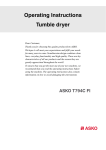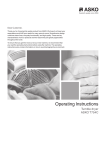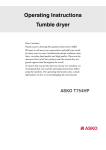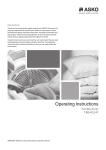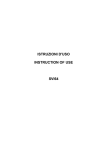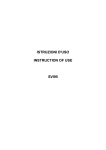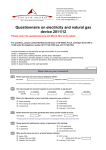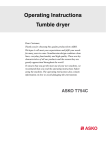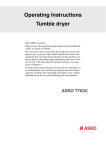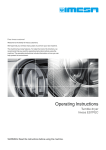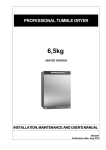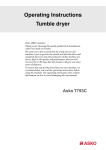Download Asko TD70.C Operating instructions
Transcript
Operating Instructions Tumble dryer Dear Customer, Thank you for choosing this quality product from ASKO. We hope it will meet your expectations and fulfil your needs for many years to come. Scandinavian design combines clean lines, everyday functionality and high quality. These are key characteristics of all our products and the reason they are greatly appreciated throughout the world. To ensure that you get the most out of your new machine, we recommend that you read the operating instructions before using the machine. The operating instructions also contain information on how to avoid damaging the environment. ASKO T784C Contents Before using your machine for the first time Language selection Safety instructions Safety 3 4 4 Transport/Winter storage 4 Packing material 4 Recycling 4 To minimize the risk of fire in a tumble dryer, the following should be observed: Child safety General Child-safe start Troubleshooting The machine will not start 17 18 18 19 21 21 21 6 6 Error messages 21 5 6 6 Advice and tips before you tumble-dry Materials that can be tumble-dried 8 Tumble drying Sort your fabrics Emptying the condensed water container Cleaning the outside of the machine Cleaning the condenser 17 The machine loses all power during a program Drying takes too long To deactivate child-safe start temporarily: Description of the tumble dryer Materials that must not be tumble-dried Static electricity 7 8 Technical information Technical data Standard tests Service Before contacting the service division Installation Positioning the tumble dryer 21 22 22 22 23 23 24 24 8 Adjusting the feet 25 8 Condensed water 26 9 Electrical installation 26 9 10 Door hanging Follow these instructions: 27 Select the program Selecting Options 13 Quick guide 32 Press the Start button 14 Drying program finished 15 Settings You can carry out the following settings Language Child-safe 2 3 Care and cleaning Cleaning the lint filter 16 16 16 16 28 Before using your machine for the first time Language selection You will be prompted to select the display language when you have connected your machine and start it for the first time. Do as follows: 1. Turn the program selector to choose from: US English, English, Svenska, Dansk, Norsk, Suomi, Français, Deutsch, Italiano, Espanol, Русский, Nederlands. 2. Press Start once to save the setting. Laundry labels Certain materials are not suitable for tumble-drying. Always check and follow the instructions on each item’s laundry label. You can find more information in the Advice and tips before you tumble-dry chapter. NOTE! When starting the tumble dryer for the first time or after a long period without use, you may notice a slight thumping noise. This noise is completely normal and will disappear after a few loads. 3 Safety instructions Read the operating instructions and keep them in a safe place! • Electrical installation, if required, should be carried out by a qualified electrician. • The machine should only be used for tumble-drying as described in these instructions. • Repairs and maintenance must be carried out by a qualified professional. • Damaged mains cables must only be replaced by a qualified electrician. • Sufficient ventilation is required to prevent smoke from open fires or fumes from equipment burning other fuels being sucked into the room when the tumble dryer is running. • Do not dry dirty laundry in the tumble dryer. • Items that are stained with e.g. cooking oil, acetone, alcohol, petrol, kerosene, stain remover, turpentine, wax and wax remover should be washed in hot water with extra detergent before they go in the tumbler dryer. • Items such as foam rubber, latex, plastic, waterproof textiles, rubber-coated items and clothes and foam-rubber filled cushions must not be dried in the tumbler dryer. • Fabric softener or similar products should be used as per the recommendations of the detergent manufacturer. • The machine is not designed to be used by persons (even children) that are physically or mentally handicapped or lack experience and knowledge. Such persons must receive instruction in how to use the machine from the person responsible for their safety. • Children must be watched to ensure they do not play with the machine. 4 Safety • The machine must not be used for drying items that have been dry-cleaned at home or fabrics that may contain residues of flammable liquids. • The tumble dryer is protected by an overheating cut-out. This shuts off the machine if the temperature gets too high. • The appliance is not intended for use by young children or infirm persons without supervision. • The machine automatically cuts off if the condenser water tank is full or outlet hose is blocked. WARNING! When the tumble dryer is operating, the back of the tumble dryer will get very hot. Leave the machine to cool completely before touching the back. Installation See the section Installation. Transport/Winter storage If you need to move your machine or store it over the winter in unheated premises, make sure that you drain the condensed water container beforehand. Packing material Sort waste materials in accordance with local guidelines. Recycling This machine is manufactured and labelled for recycling. In order to prevent personal injury, the machine must be made inoperable after deciding to take it out of service. Contact your local authority for information about where and how your machine should be correctly recycled. Safety instructions To minimize the risk of fire in a tumble dryer, the following should be observed: • Items that have been spotted or soaked with vegetable or cooking oil constitute a fire hazard and should not be placed in a tumble dryer. Oil-affected items can ignite spontaneously, especially when exposed to heat sources such as in a tumble dryer. The items become warm, causing an oxidation reaction in the oil. Oxidation creates heat. If the heat cannot escape, the items can become hot enough to catch fire. Piling, stacking or storing oil-affected items can prevent heat from escaping and so create a fire hazard. If it is unavoidable that fabrics that contain vegetable or cooking oil or have been contaminated by hair care products be placed in a tumble dryer they should first be washed in hot water with extra detergent this will reduce, but not eliminate, the hazard. The ’cool down’ cycle of tumble dryers should be used to reduce the temperature of the items. They should not be removed from the tumble dryer or piled or stacked while hot. • Items that have been previously cleaned in, washed in, soaked in or spotted with petrol/gasoline, dry-cleaning solvents or other flammable or explosive substances should not be placed in a tumble dryer. Highly flammable substances commonly used in domestic environments include acetone, denatured alcohol, petrol/gasoline, kerosene, spot removers (some brands), turpentine, waxes and wax removers. • Items containing foam rubber (also known as latex foam) or similarly textured rubberlike materials should not be dried in a tumble dryer on a heat setting. Foam rubber materials can, when heated, produce fire by spontaneous combustion. • Fabric softeners or similar products should not be used in a tumble dryer to eliminate the effects of static electricity unless this practice is specifically recommended by the manufacturer of the fabric softener or product. • Undergarments that contain metal reinforcements should not be placed in a tumbledryer. Damage to the tumble dryer can result if metal reinforcements come loose during drying. When available a drying rack could be used for such items. • Plastic articles such as shower caps or babies’ waterproof napkin covers should not be placed in a tumble dryer. Rubber-backed articles, clothes fitted with foam rubber pads, pillows, galoshes and rubber-coated tennis shoes should not be placed in a tumble dryer. Vented dryers • There has to be adequate ventilation to avoid the back flow of gases into the room from appliances burning other fuels, including open fires, when operating the tumble dryer. • The exhaust air must not be discharged into a flue which is used for exhausting fumes from appliances burning gas or other fuels. CAUTION! Air from the tumble dryer must not be fed through ducts used for equipment that burns gas or other fuels. 5 Child safety General WARNING! Do not allow children to play with the tumble dryer. • If the door is opened when a program is running the garments may be very hot, with a risk of burn injuries. • The tumble dryer does not start automatically when the door is closed (if a child pulls the door shut from the inside, for example). Child-safe start By activating the child-safe start function you can prevent children from starting the tumble dryer or changing the current program. 1. Turn off the machine using the main power switch. 2. Press and hold the + button and the Energy Save button and then turn on the main power switch. 3. Turn the program selector and choose “Child-safe On” or “Child-safe Off”. 4. Press the Start button to save. To deactivate child-safe start temporarily: Simultaneously press the Energy Save button and the minus button under Delayed Start to deactivate child-safe start for three minutes. 6 Description of the tumble dryer 1 2 3 4 5 6 7 1. 2. 3. 4. Main power switch Condensed water container Panel Serial Number 5. 6. 7. Lint filter Outer door Condenser 7 Advice and tips before you tumble-dry Here are some tips that may help you before you begin tumble-drying. Have the clothes been spun? Items to be tumble-dried should be spun at 1000 rpm or faster. Higher spin speeds save energy and reduce drying time. Materials that can be tumble-dried Static electricity To reduce the risk of static electricity in the laundry after tumble drying you can: • Use fabric softener when washing. • Wait five minutes after the drying program ends before opening the door and removing the laundry from the dryer. NOTE! This symbol means that the material is suitable for tumble-drying. Fabrics best suited to tumble-drying are cotton fabrics, terry cloth and synthetic fibres. Garments will be softer and lighter when tumbled than when hung out to dry. You can stop the tumble dryer by pressing the Stop button for three seconds or by opening the door. In both cases the program is stopped and starts from the beginning if restarted. NOTE! If you do not want to restart the program then immediately remove all laundry and spread it out to allow the heat to dissipate. The tumble dryer does not cause any significant wear on fabrics. The lint that collects in the lint filter consists of dust and fibre residues formed when the items are used. Materials that must not be tumble-dried This symbol means that the material is not suitable for tumble-drying. Certain materials may melt or become a fire hazard if exposed to heat, and others can lose their shape or shrink. And do not tumble-dry • • • • • 8 materials labelled "Do not dry near heat". garments that have been dry-cleaned at home. plastic foam. fibreglass material. wool because of the risk of felting. Tumble drying Below are step-by-step instructions to help you achieve the best possible tumble-drying results. 1 Sort your fabrics You will achieve the most uniform drying results if the items are made of the same type of material. Do up zips and buttons, fasten belts, sort the items and adjust the load and temperature. 2 Press the main power switch until the display lights. 3 Open the door, load the items and then close the door 9 Tumble drying 4 Select the program Program selector Display window Main power switch Options buttons Start Stop Select a program by turning the program selector. The selected program is shown in the display window. Use the option buttons to select any options. Guidelines as to what specific programs can be used for: Auto extra dry This program is for items that are particularly difficult to dry. NOTE! Knitted fabrics in particular are prone to shrinkage. Use the Auto extra dry, Auto normal dry or Auto Iron dry programs for these items. Stretch clothes back into shape immediately after drying. Auto dry and Auto normal dry These programs end automatically when the load is dry. The Auto dry program gives slightly drier laundry than Auto normal dry. Program intended for large and small loads of thick terry cloth, such as towels and bathrobes. Down Gentle program that dries down items completely. Can be used to dry up to three pillows or one quilt. Timed dry The most suitable program time depends on what you intend to do with the items after tumble-drying them. Use trial and error to find out what works best. When you use Timed dry to tumble-dry a load of mixed fabrics, some of the garments may remain damp. Tumble-dry any damp garments for a further 30 minutes or so using the Timed dry program. This program shuts off the heat once the load is just damp enough for ironing or pressing. Select the program time by pressing the + and buttons. A program time between 30 minutes and 3 hours can be selected and each button press changes the time by 15 minutes. Jeans NOTE! Program for jeans and clothing with very thick seams. Delayed Start can be selected as an option. When using the Timed dry program with a program time that is too long, the garments can become “over-dry”. This can cause items to shrink or crease and feel rough to the touch. Synthetic materials can also become charged with static electricity. Auto Iron dry Synthetics Gentle program for synthetics. Delayed Start can be selected as an option. 10 Terry towels Tumble drying Revitalise Use the Air fluff program when you just want to refresh, air or soften up items. Select the program time by pressing the + and buttons. A program time between 15 minutes and 3 hours can be selected and each button press changes the time by 15 minutes. 11 Tumble drying Program chart Here we present the energy and time consumption of a few different programs. The table shows the effect of using different spin speeds when washing the load. Consumption can vary depending on room temperature, humidity, load, variations in the power supply and selected options. For the consumption values given below, the requirements are as follows: Temperature of intake air: 23 °C Moisture content of intake air: 55 % Drying temperature: Normal Heater output: 1950W, 10A Program Material Auto extra dry Cotton, linen Auto dry Auto normal dry Auto Iron dry 12 Cotton, linen Load Spin speed (rpm) Energy consumption, approx. Program time, approx. (min) (kWh) 1/1 1/1 800 rpm 4,2 2:15 1000 rpm 3,9 2:05 1400 rpm 3,4 1:50 1600 rpm 3,3 1:45 800 rpm 4,0 2:05 1000 rpm 3,6 1:55 1400 rpm 3,2 1:45 1600 rpm 3,0 1:40 Crease-resistant, polyester/cotton 1/2 1000 rpm 1,9 1:05 Cotton, linen 1/1 800 rpm 3,9 2:00 1000 rpm 3,6 1:50 1400 rpm 3,1 1:40 1600 rpm 2,6 1:25 Crease-resistant, polyester/cotton 1/2 1000 rpm 1,3 0:40 Cotton, linen 1/1 800 rpm 3,8 1:55 1000 rpm 3,3 1:40 1400 rpm 2,6 1:25 1600 rpm 2,0 1:05 Tumble drying 5 Selecting Options By selecting options, you can tailor a drying program to suit your requirements. The available options depend on the selected program. Once you have started the program, the options you selected are saved for the next time you use the same program. The exception is Delayed Start, which is not saved for the next time. Energy Save You can select Energy Save with all programs except Revitalise. • Select Energy Save by pressing the button under the symbol. • The symbol lights when Energy Save is selected. Audible Volume You can choose to have the machine notify you when a program is finished or if an error has occurred. • Select Audible Volume by pressing the button under the symbol. • The symbol lights when Audible Volume is selected. Anti crease This option means that the drum will rotate for three seconds per minute for two hours after the drying program has finished. This option prevents items from remaining in the same position and becoming creased if you are unable to remove them immediately after tumble-drying has finished. Cannot be selected with the Revitalise program. If the Audible Volume option has also been activated, an audible signal will sound each time the drum rotates as a reminder that the drying program has finished. • Select Anti crease by pressing the button under the symbol. • The symbol lights when Anti crease is selected. Delayed Start First select which program you want to use and then select Delayed Start by pressing the + button. The display shows Delayed Start in whole hours. Press the + / - button to select a delayed start of 1 to 24 hours. The symbol for Delayed Start lights next to the number of hours. Press the Start button and the machine counts down 1 hour at a time and starts after the selected delay. This option cannot be used with Timed dry or Revitalise. Time saver You can select Time saver with all programs except Revitalise. The program is shortened by about 12 minutes. • Press the button under the symbol. • The symbol lights when Time saver is selected. 13 Tumble drying 6 Press the Start button Remaining drying time An estimate of the remaining drying time will be shown on the display a few minutes after the drying program starts. 1:35 means that it will take approximately 1 hour and 35 minutes for the load to dry. If the Anti crease option has been selected, the drum will rotate for three seconds per minute for two hours after the program is finished. The actual remaining time may be longer than the estimated time shown on the display. The remaining time is then shown as 0:15 until the load is sufficiently dry. If you selected Time saver the display will show 0:05 instead. You can stop the tumble dryer by pressing the Stop button or by opening the door. In both cases the program is stopped and starts from the beginning if restarted. NOTE! The program will not be affected if you change the program selector after the program has started. 14 Tumble drying 7 Drying program finished The text Done appears on the display when the program is finished. If the Anti crease option has been selected, the drum will rotate for three seconds per minute for two hours after the program is finished. Backlighting Two minutes after the drying program finishes the backlighting on the display and option buttons enter energy saving mode. The condensed water is decalcified and can be used in steam irons. Pour it through a coffee filter. NOTE! • Clean the lint filter in the outer door after each load. See the Care and cleaning chapter. • Empty the condensed water container after each load. Condensed water The condensed water container must be emptied after each load. Remove the condensed water container, empty out the water and replace the container. If the condensed water container becomes full to overflowing, the program is interrupted and Over Flow appears on the display. Empty the container and press the Start button to start a new program. TIP! WARNING! If the lint filter becomes clogged, the machine’s automatic overheating cut-out may be triggered. Clean the filter, wait until the machine has cooled then try starting it. If it still does not start: call the service division. Once drying has finished Turn off the main power switch. Remove the clothes and close the door to prevent small children from climbing into the machine. 15 Settings You can carry out the following settings • Language • Child-safe Language Follow these instructions: 1. Turn off the machine using the main power switch. 2. Press and hold the Start button and then press the main power switch. 3. Turn the program selector to choose from: US English, English, Svenska, Dansk, Norsk, Suomi, Français, Deutsch, Italiano, Espanol, Русский, Nederlands. 4. Press the Start button to save. Child-safe Activating/deactivating Child-safe start 1. Turn off the machine using the main power switch. 2. Press and hold the + button and the Energy Save button and turn on the main power switch. 3. Turn the program selector and choose Child-safe On or Child-safe Off. 4. Press the Start button to save. You can temporarily deactivate Child-safe start for three minutes by pressing the Energy Save button and the minus button under Delayed Start at the same time. 16 Care and cleaning Cleaning the lint filter The lint filter must be cleaned after each load. 1. Lift the filter from the holder in the door. 3. Use your hand or a soft cloth to remove the lint from all sides of the filter. If necessary, use a damp sponge and a small amount of washing-up liquid to remove any deposits. Dry the filter thoroughly with a towel. 4. Close the lint filter and put it back in the door.Close the lint filter before closing the door. 2. Open the lint filter. Use your thumb to press on the edge as illustrated and pull it out. 17 Care and cleaning Emptying the condensed water container Cleaning the outside of the machine Clean the outside of the machine and the program panel with a mild cleaner. Do not use solvents, as these can damage the machine. Do not hose down or spray the machine with water. NOTE! Do not allow dust to accumulate around the machine. Keep the area around the tumble dryer clean and cool; dust, heat and moisture prolong drying times. If you have not connected the machine to a separate drain the condensed water container must be emptied after each load. Remove the condensed water container, empty out the water and replace the container. If the condensed water container becomes full to overflowing, the program is interrupted and “Over Flow” appears on the display. Empty the container and press the Start button to restart the program. For connection to a separate drain, see the installation instructions in the set of documents. 18 Care and cleaning Cleaning the condenser The condenser should be cleaned at least three times a year. If you have pets, the condenser must be cleaned more frequently. 1. Turn off the tumble dryer with the main power switch and open the outer door. 2. Remove the plinth. NOTE! Do not clean the condenser in a dishwasher. 5. Wipe any lint from the channel in front of the condenser and inside the condenser compartment. Use a cotton bud or similar item to remove any lint from the drain hole at the front edge of the compartment. 3. Open the condenser panel by turning the two knobs. NOTE! 4. Remove the condenser and rinse the ribs clean, such as with a hand-held shower. Do not poke around in the rib gaps as you may damage the condenser. Do not use pointed metal objects when cleaning. It is quite normal for water to collect in the channel in front of the condenser. 6. Replace the condenser with the handle facing down as illustrated. 19 Care and cleaning UPP UP OBEN 7. Reattach the plinth. 20 Troubleshooting The machine will not start Drying takes too long Check • that the door is properly closed. • that the main power switch is on. • that the Delayed Start option has not been selected. To cancel Delayed Start, press the Stop button for three seconds. • that the plug is connected. • that the main fuses have not blown. • that the overheating cut-out has not been triggered. • Check that the lint filter is not blocked. See the Care and cleaning chapter. • Empty the condensed water container and check that the condenser is not blocked. See the Care and cleaning chapter. • Overly long drying times may also be due to the tumble dryer being located in a confined area or in a room that is too small, causing the air to become too hot. • Make sure that the tumble dryer has access to more cold air, open doors and/or windows, for example. The machine loses all power during a program The overheating cut-out shuts off the tumble dryer if the temperature is too high, e.g. because dust is clogging the lint filter. • Clean the lint filter. • Check also that the condensed water container is not full and, if necessary, clean the condenser. See the Care and cleaning chapter. • Wait until the machine has cooled then try starting it. If it still does not start: Call the service division. Error messages • If Over Flow appears on the display, the condensed water container is full. Empty the container and restart the machine. • Read Drying takes too long in this chapter if Max program time appears on the display. • If Clean Lint Filter appears on the display, clean the lint filter. • If Clean condenser appears on the display, clean the condenser. See the Care and cleaning chapter. • Call the service division if Thermistor fault appears on the display. • Press the Stop button to close any error messages. 21 Technical information Technical data Height: 850 mm Width: 595 mm Depth: 585 mm Weight (net): 44 kg Cylinder volume: 112 l Max. drying capacity: 6,5 kg Speed: 50-55 rpm Rated power: See type plate. Drum material: Stainless steel Outer casing material: Powder-coated and hot-galvanized sheet steel or stainless steel. Setup Stacking or freestanding Standard tests For the standard test the machine’s condensed water hose must be connected to a drain. Australia: Drying performance: AS/NZS 2442.1:1996.Auto normal dry,6,5 kg cotton, temperature Normal, Time saver. Energy declaration: AS/NZS 2442.1:1996.Auto normal dry, 6,5 kg cotton, temperature Normal, Time saver. Test method for noise measurement: IEC 60 704-2-6. 22 Service Before contacting the service division See the Troubleshooting and Care and cleaning chapters to see whether you can rectify the problem. If you need to contact the service division, make sure that you know the model designation, type designation and serial number. The model designation (1) can be found on the first page of the operating instructions and on the machine panel. The type designation (2) and serial number (3) can be found on the type plate, which is found on the front of the tumble dryer inside the outer door. 1 2 TYPE TD70.2 3 23 Installation Positioning the tumble dryer How to assemble the stack: The tumble dryer can be free-standing or in a stack. Remember that the tumble dryer produces heat and should therefore not be located in a room that is too small. If the room is very small, drying will take longer due to the limited quantity of air. 1. Remove the two tip guards from the back of the tumble dryer. Replace the screws that held the tip guards in place. WARNING! • Any electrical installation must be carried out by qualified professionals. • The machine must not be installed behind a lockable door, a sliding door or a door with hinges on the opposite side to those of the tumble dryer. • The tumble dryer's plinth ventilation must not be blocked by a rug or the like. 2. Undo the two screws indicated on the back of the washing machine. NOTE! To improve ventilation, leave the door to the room where the tumble dryer is located open. Freestanding The tumble dryer can be positioned beside the washing machine. Stacking The tumble dryer can be placed on top of a ASKO washing machine. Use the two foot cups found in the document bag included with the machine and the two tip guards attached to the bottom left corner of the back of the machine. 3. Secure the anti-tilt device using the screws as shown in the picture. 4. Attach the plastic cups for fixing the tumble dryer’s front feet to the washing machine’s top cover. This is essential, as only when the 24 Installation tumble dryer’s feet are resting in the plastic cups can you be sure that the tumble dryer is correctly positioned on the washing machine. Break off tag A on the cup fitted on the right-hand side and tag B on the cup fitted on the left-hand side. Then remove the paper from the self-adhesive surface under the plastic cups. 8. Lower the tumble dryer’s front feet into the plastic cups and adjust the tumble dryer to ensure it is level. A A BB 5. Fit the plastic cups so that the “tags” marked with arrows are against the front edge or side edge of the cover and press them firmly onto the cover. Then break off the remaining tags. Adjusting the feet Screw the feet in or out so that the tumble dryer is both stable and level. 6. Push out the knock-out hole on the back of the tumble dryer (you must not remove it, just open it) using a hammer and screwdriver. 7. Push the tumble dryer in under the metal brackets. At the same time keep the front edge raised by 10 mm to 20 mm. 25 Installation Condensed water The machine is supplied as shown in Option 1 (inset). This means that the condensed water is pumped into the condensed water container, which must be removed and emptied by hand. Option 2 allows you to remove the small short hose from the nipple. Attach the rubber hose supplied to the same nipple. The water can then be pumped out into a sink or a floor drain (2a). 2 Max 1000 mm 1 2a Electrical installation Connect the machine by plugging it into an earthed wall socket. The electrical wall socket must be placed outside of the installation area to be easily accessible. If this appliance is supplied from a cord extensions set or electrical portable outlet device, the cord extension ser or electrical portable outlet device must be positioned so that it is not subject to splashing or ingress of moisture. Connection on delivery • • • • 26 230V, 1-Phase, 10A 50Hz Heat output 1950W, 10A Use a type A residual current device. Door hanging 1 6 1. 2. 3. Hinge pins (top and bottom) Cover plate Plastic plugs (on the upper and lower edges) 2 3 4 5 4. 5. 6. Locking hook Hinges (left + right side) Plinth 27 Door hanging You can choose whether the door is hung on the right or the left. Follow these instructions: 1. Remove the plinth. 2. Remove the hinge, two screws. 3. Lift the door up and remove it. Support the door at the same time. 4. Remove both door pins (top and bottom). Fit them on the other side of the machine. Refit the hinge. 5. Loosen and remove the catch (lift up and pull out) and the cover plate on the door and the machine. Switch the catch and the cover plate. 1 2 28 6. Move the plastic plugs on the upper and lower edges of the door. Use a flat-bladed screwdriver to remove the plugs. 7. Refit the door by loosening the hinge screws slightly, affixing the door and closing it. Retighten the hinges. Replace the plinth. Your notes 29 Your notes 30 Your notes 31 Quick guide 1 2 3 4 Fabrics • Dry fabrics of the same type together to ensure that they dry as evenly as possible. Turn on the main power switch Load the garments • Close the door. Select a program and any options • Turn the program selector to the required program. • Select any options and settings. Art. No.: 8092900. Rev. 02. We reserve the right to make changes. 32 5 6 Press the Start button Drying program finished • Done appears on the display when the program is finished. If the Anti crease option has been selected, the drum will rotate for three seconds per minute for two hours after the program is finished. • Clean the lint filter after each load. 7 Once drying has finished • Turn off the mains power switch and close the door.
































